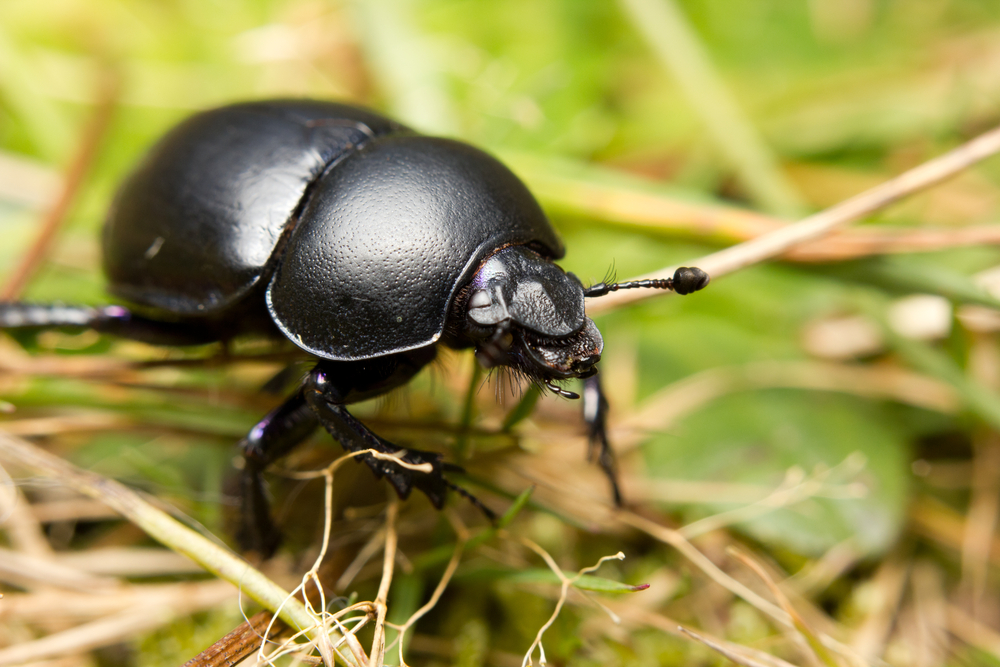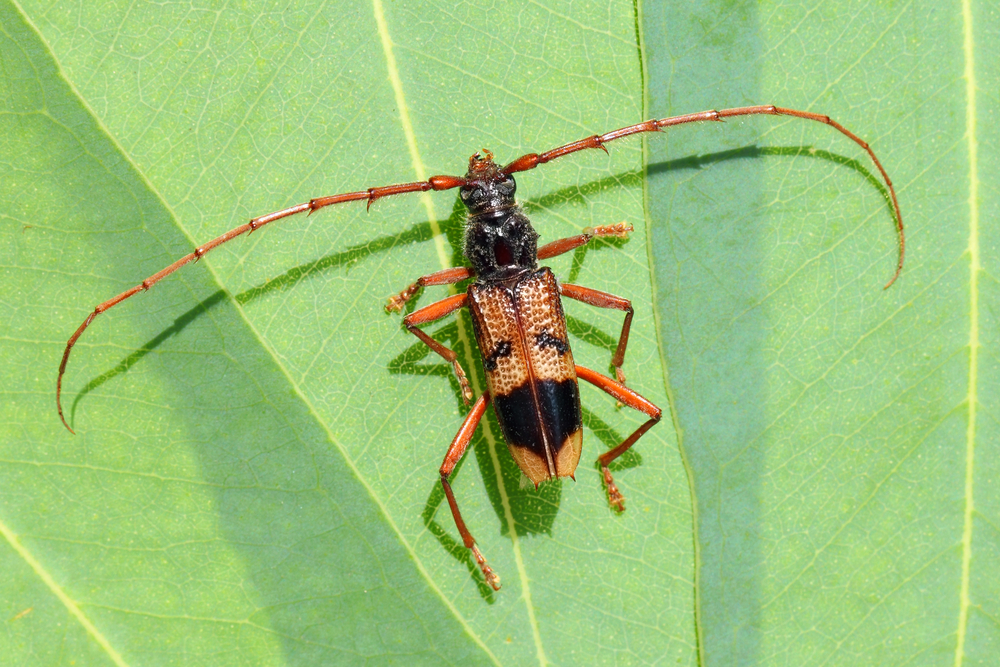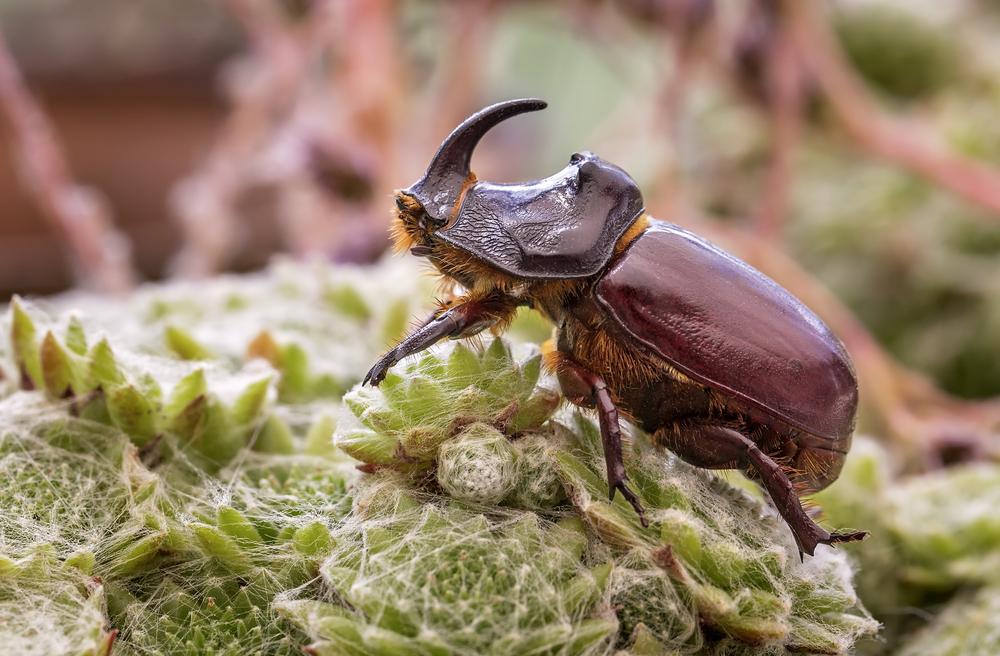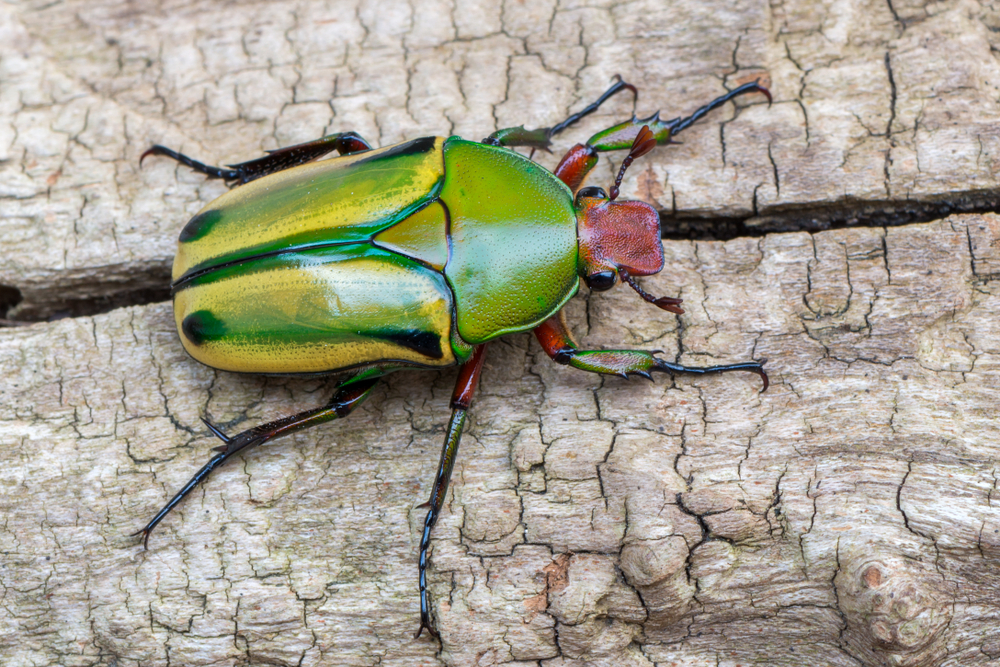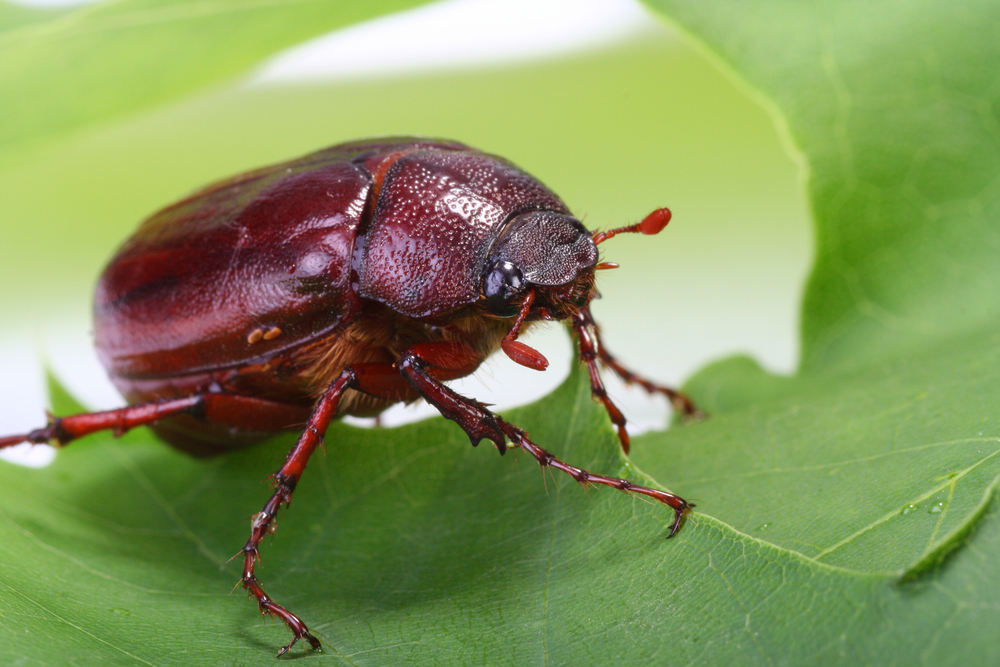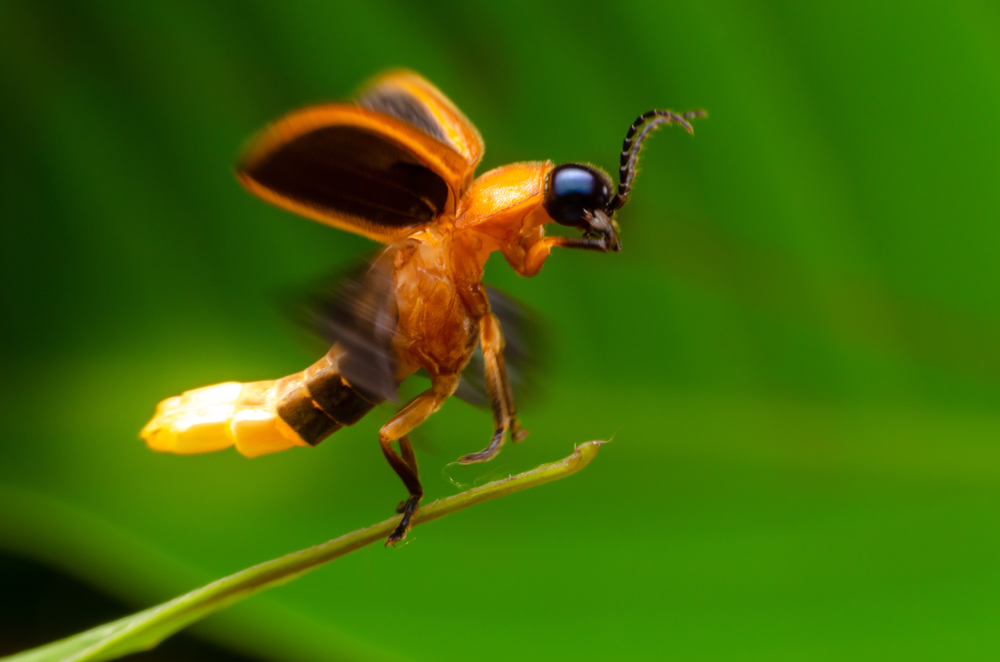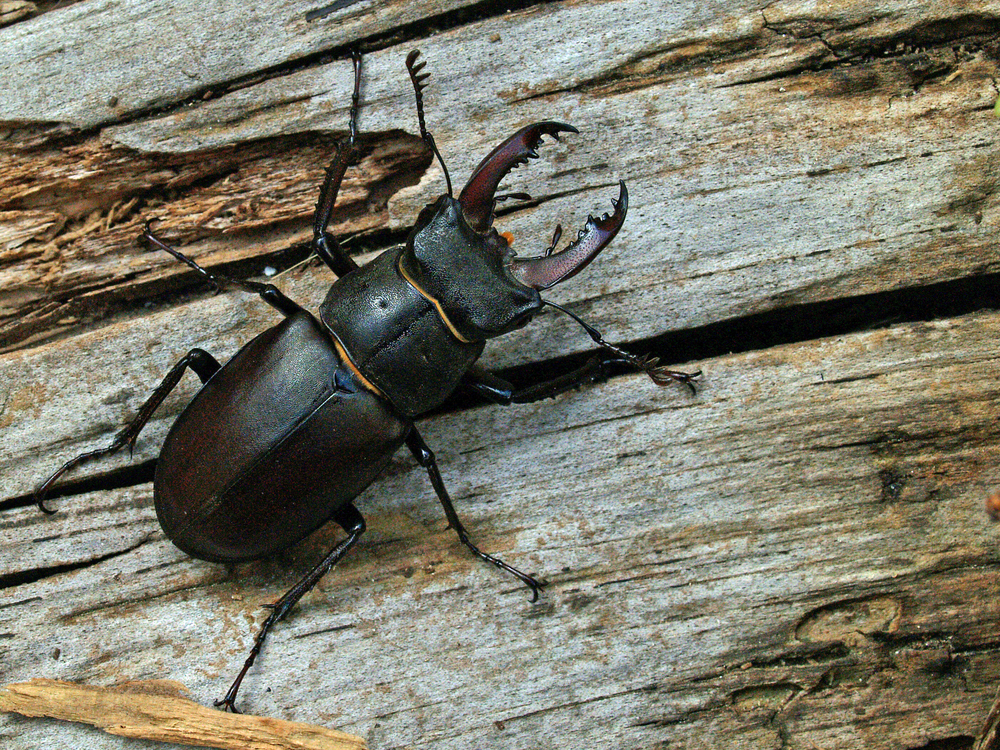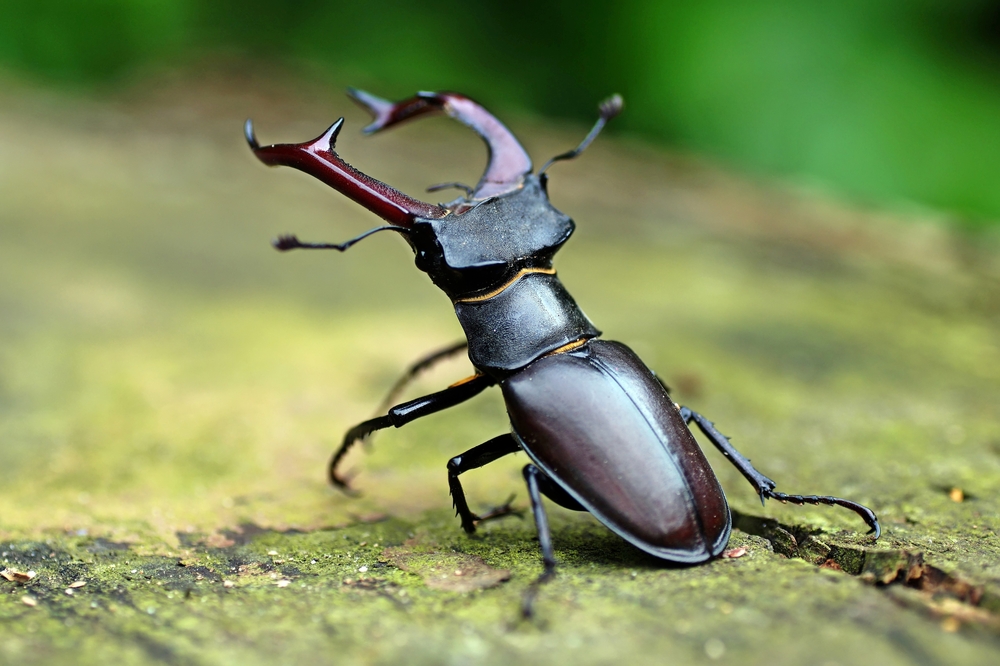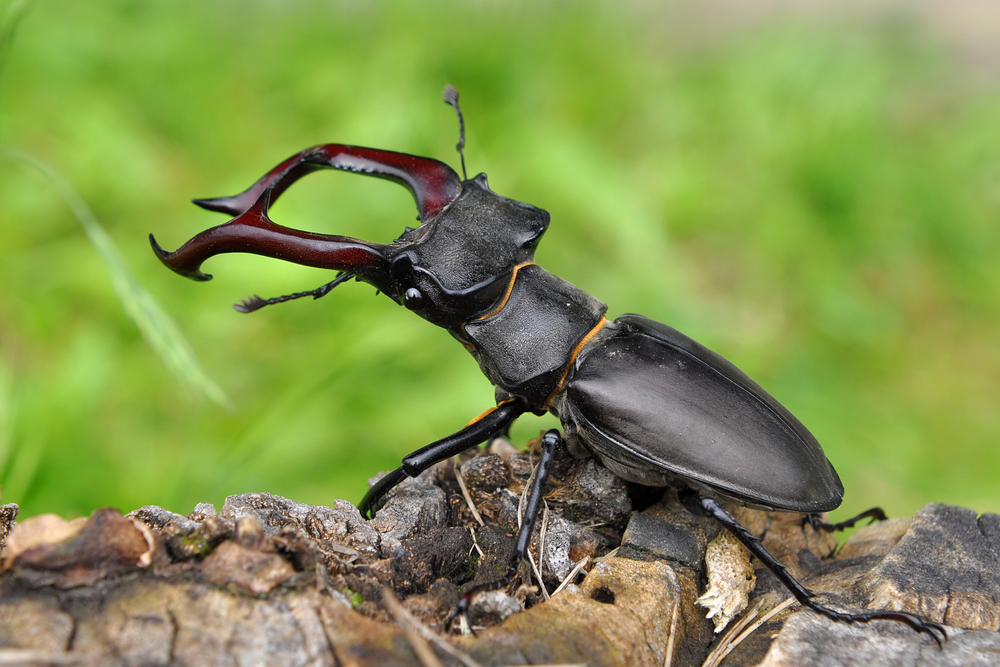There are over 1,200 recognized species of stag beetles belonging to the family Lucanidae. These species exhibit a wide range of sizes, shapes, and behaviors, and are found in diverse habitats across the world. The diversity within the family Lucanidae reflects the adaptability and evolutionary success of stag beetles in various ecological niches.
About
Stag beetles, encompassing the family Lucanidae, stand out as striking members of the insect world, celebrated for their formidable mandibles and notable size. These beetles, nestled within the order Coleoptera of the Animal Kingdom, boast one of the most diverse arrays of species, with over 1,200 types spread globally. The term “stag beetle” primarily originates from the oversized, antler-like mandibles of the males, reminiscent of a stag’s antlers, which are used in combat over mating rights and territories.
Stag beetles inhabit a wide range of environments, from the leafy forest floors of temperate regions to the lush canopies of tropical rainforests. The larvae are wood-dwellers, living within decaying logs and tree stumps, playing a crucial role in the process of decomposition and nutrient cycling. The adult beetles often emerge at dusk, embarking on flights in search of mates and nourishment.
The distinct lifecycle and morphology of stag beetles, coupled with their ecological roles, render them a fascinating subject of study and admiration. Despite their fierce appearance, these beetles are a vital part of the ecological tapestry, contributing to the health and balance of their natural habitats. Their presence underscores the incredible diversity and complexity inherent within the Animal Kingdom.
Physical Characteristics
Stag beetles are recognized for their distinctive and robust appearance, primarily characterized by the males’ oversized, antler-like mandibles. These mandibles are used for combat and courtship displays and can be quite large relative to the beetle’s body. Stag beetles typically have a shiny, hard exoskeleton that can range in color from black to reddish-brown. The body is divided into the head, thorax, and abdomen, with the thorax housing a pair of strong, leathery wings under a pair of hard protective wing cases known as elytra.
Physical characteristics of stag beetles, including size and weight, can vary among different species:
- Size:
- Length: Stag beetles vary in size depending on the species, with body lengths ranging from about 0.5 inches to 3.5 inches (1.2 cm to 9 cm). Some of the larger species, particularly males with their extended mandibles, can reach lengths at the upper end of this range.
- Width and Height: Their width and height are proportionate to their length, giving them a stout and robust appearance.
- Weight:
- Stag beetles are relatively lightweight due to their small size. They typically weigh between 0.01 pounds and 0.07 pounds (5 to 30 grams), with most species on the lighter end of that range.
Stag beetles’ unique mandibles, hard exoskeleton, and impressive size make them one of the more notable and easily recognizable beetles. Their physical attributes are not only key to their survival and mating success but also contribute to the fascination and interest they garner among entomologists and beetle enthusiasts.
Reproduction
The reproductive cycle of stag beetles is intriguing and quite extensive, often taking several years from egg to adult, primarily due to the lengthy larval stage. Here’s an overview of their reproductive process:
- Mating: Adult stag beetles emerge in late spring to early summer, primarily for the purpose of reproduction. The males use their large mandibles to fight over females and territories. After mating, the females lay eggs in or on the ground, often near or in decaying wood, which is an essential habitat for the larvae.
- Egg-Laying: A female stag beetle typically lays her eggs individually or in small batches, depositing them in rotting wood or soil. The number of eggs laid varies among species but is usually around 20 to 40.
- Larval Stage: Once the eggs hatch, the larvae (grubs) emerge and immediately begin feeding on decaying wood. This larval stage is the longest phase in the stag beetle’s life cycle, lasting several years (commonly 3 to 7 years, depending on environmental conditions and species). The larvae go through several instars, growing larger and molting several times.
- Pupation: After reaching full size and completing the larval stage, the grub pupates within the decaying wood or soil. During this pupal stage, the beetle transforms into its adult form. This stage can last from several weeks to several months, again depending on the species and environmental factors.
- Emergence of Adults: After pupation, the adult stag beetles emerge. Adults have a relatively short lifespan, typically living for just a few months. Their primary purpose during this time is to reproduce, starting the cycle anew.
The lengthy larval stage of stag beetles, where the grubs feed on decaying wood, contributes significantly to the ecosystem by aiding in the decomposition process and nutrient cycling. However, this dependence on decaying wood means that habitat loss and the removal of old trees can severely impact their populations. The entire life cycle of stag beetles, particularly the extended larval phase, reflects the intricate balance and timing in nature’s processes.
Lifespan
The lifespan of stag beetles is characterized by a significant portion of their life spent in the larval stage, with a relatively short adult phase. Here’s an overview of their lifespan in the wild and in captivity, as well as the primary threats they face:
Lifespan
- In the Wild:
- Larval Stage: The larval stage is the longest phase in the stag beetle’s life cycle, lasting from 3 to 7 years, depending on the species and environmental conditions. During this time, larvae feed on decaying wood, growing through several instars (stages) before pupating.
- Adult Stage: Once they emerge as adults, stag beetles have a brief lifespan, usually living for only a few months. Their primary purpose during this time is to mate and, for females, lay eggs.
- In Captivity:
- Stag beetles can have a similar lifespan in captivity as in the wild. However, with optimal conditions, the risk of predation reduced, and a steady supply of food, some stages, particularly the larval stage, may be shorter.
Biggest Threats
- Habitat Loss: The removal of old trees and forests for urban development or agriculture reduces the availability of decaying wood, which is crucial for the larval stage of stag beetles.
- Pesticides and Pollution: Chemicals used in forestry and agriculture can contaminate the stag beetles’ habitat, posing a threat to their food sources and their health.
- Climate Change: Changes in climate can alter the habitats of stag beetles, affecting the availability of their food sources and potentially disrupting their developmental cycles.
- Collection and Trade: In some regions, stag beetles are collected for trade, which can lead to local population declines, especially for certain desirable species.
Stag beetles are an integral part of forest ecosystems, contributing to the decomposition of dead wood and nutrient recycling. Protecting their habitats and ensuring the availability of decaying wood is crucial for their conservation and the health of forest ecosystems.
Eating Habits
Stag beetles have distinct eating habits that vary significantly between the larval and adult stages. The larvae are primarily detritivores, feeding on decaying wood, while the adults have a more varied diet that can include plant materials and tree sap.
- Larval Stage (Grubs):
- The larvae of stag beetles, known as grubs, feed on rotting wood. This diet is rich in cellulose and provides the necessary nutrients for growth and development.
- Larvae have strong, chewing mouthparts suited for breaking down tough wood fibers. They spend their time within the wood, creating tunnels as they consume the decaying material.
- The digestion of wood is aided by symbiotic microorganisms in the larvae’s gut, which help break down cellulose into nutrients the larvae can absorb.
- Adult Stage:
- Adult stag beetles have a different diet and feeding behavior compared to their larval stage. They primarily feed on plant sap, nectar, and fruit.
- They are not typically seen feeding on solid foods, as their adult mouthparts are not as well adapted for chewing as their larval counterparts.
- Adults can often be found on tree trunks, feeding on sap flows, or on overripe fruits, where they can consume the juices.
It’s interesting to note that adult stag beetles do not feed as actively or as much as their larvae. The primary focus of the adult stage is reproduction, and many adults have a relatively short lifespan during which they may not need to feed much at all. The larvae, on the other hand, have a high nutrient requirement to support their growth and development, hence their voracious feeding on decaying wood. The decomposition process carried out by the larvae plays a crucial ecological role, contributing to nutrient cycling and soil formation.
Uniqueness
Stag beetles stand out in the insect world for several unique characteristics that distinguish them from other beetles and insects:
- Impressive Mandibles: Male stag beetles are renowned for their large, antler-like mandibles, which are often used in battles over territory and mates. These mandibles resemble the antlers of a stag, hence the name “stag beetle.” Despite their fearsome appearance, the mandibles are generally not used for feeding but rather for gripping opponents and for display to attract females.
- Variety in Size and Form: Stag beetles display a remarkable variety in size and form, with some species among the largest of beetles. Their size, combined with their prominent mandibles and often glossy exoskeletons, makes them visually striking.
- Complex Lifecycle: The lifecycle of a stag beetle, particularly the extended larval stage lasting several years, is notable. The larvae live in and feed on decaying wood, playing a crucial ecological role in breaking down and recycling nutrients.
- Adult Diet and Behavior: Unlike the larvae, adult stag beetles often feed on sap, fruit, and nectar. Some adult stag beetles have a reduced need for feeding, focusing primarily on reproduction during their relatively short adult life.
- Contribution to Ecosystems: Stag beetles contribute significantly to forest ecosystems. The larvae aid in the decomposition of dead and decaying wood, facilitating nutrient cycling and soil formation. Adults, through their feeding on tree sap and fruit, can help in the dispersal of plant seeds and pollen.
- Sensitivity to Environmental Changes: Stag beetles are sensitive to changes in their environment, particularly habitat loss and the removal of dead wood. Their presence and population health can be indicators of the overall health of forest ecosystems.
- Celestial Navigation: Some studies suggest that certain species of stag beetles may use celestial cues for navigation, a fascinating aspect that highlights the complex behaviors insects are capable of.
The unique combination of their striking appearance, important ecological role, and complex behaviors make stag beetles a subject of interest and importance in biodiversity and conservation efforts. Their presence is a testament to the intricacies and interdependencies of natural ecosystems.
FAQ’s
1. How many types of Stag Beetles are there?
2. What are the more popular stag beetles?
Stag beetles are a diverse group of insects known for their distinctive antler-like mandibles. Here are 10 popular stag beetle species:
- Lucanus cervus (European Stag Beetle): Iconic, large, and dark brown with impressive mandibles. Found in Europe, often in woodlands.
- Dorcus titanus (Titan Beetle): Massive and powerful, it’s among the world’s largest beetles, found in Southeast Asia.
- Prosopocoilus giraffa (Giraffe Stag Beetle): Named for its long neck, found in Southeast Asia, and highly prized by collectors.
- Odontolabis wollastoni (Wollaston’s Stag Beetle): Striking colors and horn-like mandibles, native to Southeast Asia.
- Platycerus caraboides (Lesser Stag Beetle): Smaller, reddish-brown, and widespread in European woodlands.
- Prosopocoilus confucius (Confucius Stag Beetle): Attractive green and black coloring, inhabiting parts of Asia.
- Cyclommatus metallifer (Jewel Stag Beetle): Metallic appearance, often iridescent, living in Southeast Asian forests.
- Lucanus elaphus (Giant Stag Beetle): One of North America’s largest, brownish-black, with long mandibles.
- Neolucanus maximus (Sawtooth Stag Beetle): Named for serrated mandibles, found in Japan and East Asia.
- Sinodendron cylindricum (Cylindrical Stag Beetle): Cylindrical body shape, found in Eurasian forests, and active at night.
Related Family Species
Sources
- Britannica, Stag Beetle, https://www.britannica.com/animal/stag-beetle, retrieved January 2024.
- Burnie, David & Wilson, Don, Animal, Smithsonian Institute, Washington DC.
- Hickman et al, Integrated Principle of Zoology, McGraw Hill, Boston.































































